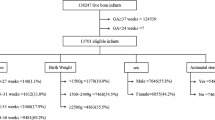Abstract
Background
There are no available predictive models for survival in extremely preterm (EP) infants admitted to a referral Level IV neonatal intensive care unit (NICU) after the first day of life (DOL).
Objective
To determine if there are clinical variables present at admission that are associated with survival in an outborn EP population.
Study design
Data were analyzed from EP infants admitted before DOL 100 from 2008 to 2016 (n = 744).
Results
We found that prophylactic indomethacin (OR 1.98 (1.20–3.25) p = 0.007), admit DOL (OR 1.05 (1.02–1.08) p < 0.001), and birth in Franklin County, (OR 2.02 (95% CI, 1.04–3.90) p = 0.04) were all associated with survival. Using ROC analysis, the area under the curve for the provisional survival score was 0.69 (95% CI, 0.64–0.75; p < 0.0001).
Conclusions
There are factors on admission to a referral Level IV NICU associated with survival in EP patients.
This is a preview of subscription content, access via your institution
Access options
Subscribe to this journal
Receive 12 print issues and online access
$259.00 per year
only $21.58 per issue
Buy this article
- Purchase on Springer Link
- Instant access to full article PDF
Prices may be subject to local taxes which are calculated during checkout



Similar content being viewed by others
References
Stoll BJ, Hansen NI, Bell EF, Walsh MC, Carlo WA, Shankaran S, et al. Trends in care practices, morbidity, and mortality of extremely preterm neonates, 1993–2012. JAMA. 2015;314:1039–51.
Alleman BW, Bell EF, Li L, Dagle JM, Smith PB, Ambalavanan N, et al. Individual and center-level factors affecting mortality among extremely low birth weight infants. Pediatrics. 2013;132:e175–84.
Helenius K, Sjörs G, Shah PS, Modi N, Reichman B, Morisaki N, et al. Survival in very preterm infants: an international comparison of 10 national neonatal networks. Pediatrics. 2017;140:e20171264.
Bartman T, Bapat R, Martin E, Shepherd E, Reber K, Nelin L. Apgar score at 5 min is associated with mortality in extremely preterm infants even after transfer to an all referral NICU. Am J Perinatol. 2015;32:1268–72.
Moorehead PA, Martin E, Shepherd E, Parikh N, Reagen P, Gardner W, et al. Factors associated with survival of <27 week infants in an all-referral neonatal intensive care unit. J Neonatal Perinat Med. 2012;5:105–11.
Shepherd E, Calvert TJ, Martin E, Hitchner JC, Welty S, Nelin L. Outcomes of extremely premature infants admitted to a children’s hospital depends on referring hospital. J Neonatal Perinat Med. 2011;4:45–53.
Sharma D. Golden hour of neonatal life: need of the hour. Matern Health Neonatol Perinatol. 2017;3:16.
Dammann O, Shah B, Naples M, Bednarek F, Zupancic J, Allred EN, et al. Interinstitutional variation in prediction of death by SNAP-II and SNAPPE-II among extremely preterm infants. Pediatrics. 2009;124:e101–6.
Kaaresen PI, Døhlen G, Fundingsrud HP, Dahl LB. The use of CRIB (clinical risk index for babies) score in auditing the performance of one neonatal intensive care unit. Acta Paediatr. 1998;87:195–200.
The International Neonatal Network. The CRIB (Clinical Risk Index for Babies) score: a tool for assessing initial neonatal risk and comparing performance of neonatal intensive care units. Lancet. 1993;342:193–8.
Broughton SJ, Berry A, Jacobe S, Cheeseman P, Tarnow-Mordi WO, Greenough A. An illness severity score and neonatal mortality in retrieved neonates. Eur J Pediatr. 2004;163:385–9.
Asker HS, Satar M, Yıldızdaş HY, Mutlu B, Özyurt BM, İpek MŞ, et al. Evaluation of score for neonatal acute physiology and perinatal extension II and clinical risk index for babies with additional parameters. Pediatr Int. 2016;58:984–7.
Patel RM, Kandefer S, Walsh MC, Bell EF, Carlo WA, Laptook AR, et al. Causes and timing of death in extremely premature infants from 2000 through 2011. N Engl J Med. 2015;372:331–40.
Travers CP, Carlo WA, McDonald SA, Das A, Bell EF, Ambalavanan N, et al. Mortality and pulmonary outcomes of extremely preterm infants exposed to antenatal corticosteroids. Am J Obstet Gynecol. 2018;218:130.e1–13.
Author information
Authors and Affiliations
Corresponding author
Ethics declarations
Conflict of interest
The authors declare that they have no conflict of interest.
Additional information
Publisher’s note Springer Nature remains neutral with regard to jurisdictional claims in published maps and institutional affiliations.
Rights and permissions
About this article
Cite this article
Pishevar, N., Fathi, O., Backes, C.H. et al. Predicting survival in infants born at <27 weeks gestation admitted to an all referral neonatal intensive care unit: a pilot study. J Perinatol 40, 750–757 (2020). https://doi.org/10.1038/s41372-020-0629-x
Received:
Revised:
Accepted:
Published:
Issue Date:
DOI: https://doi.org/10.1038/s41372-020-0629-x
This article is cited by
-
Development of a small baby unit to improve outcomes for the extremely premature infant
Journal of Perinatology (2022)
-
Prophylactic Indomethacin in extremely preterm infants: association with death or BPD and observed early serum creatinine levels
Journal of Perinatology (2021)



